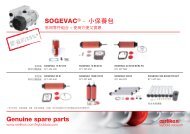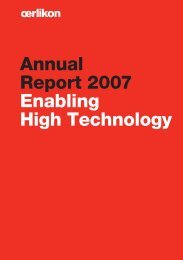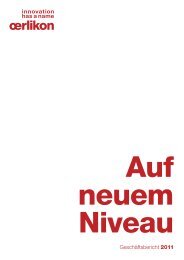Annual Report 2011 (5.07 MB, PDF-File) - Oerlikon
Annual Report 2011 (5.07 MB, PDF-File) - Oerlikon
Annual Report 2011 (5.07 MB, PDF-File) - Oerlikon
You also want an ePaper? Increase the reach of your titles
YUMPU automatically turns print PDFs into web optimized ePapers that Google loves.
122<br />
Market risk<br />
Key Figures Group Notes OC <strong>Oerlikon</strong> Corporation AG, Pfäffikon<br />
Notes to the consolidated financial statements<br />
Market risk is the risk that the fair value or the future cash flows of a financial instrument may change as a result of fluctuations in market<br />
prices. <strong>Oerlikon</strong> is exposed in particular to fluctuations in foreign exchange and interest rates. The Group also has a minor risk from<br />
exposure to fluctuations in raw material prices.<br />
The Group’s financial risk management aims to limit any adverse effects that the markets may have on the Group’s financial health, at an<br />
acceptable hedging cost. Risk limitation does not mean complete exclusion of financial risks, rather it means following a policy of economically<br />
sensible management of the Group’s finances within an agreed framework of documented authority. The Group uses derivative<br />
financial instruments to hedge certain risks. Only pre-approved instruments are used, and as a fundamental rule, no speculative<br />
transactions are conducted in the areas of foreign exchange or interest rates. No hedges are entered into without a corresponding base<br />
transaction. Management monitors and steers such risks continuously with the support of Group Treasury, who identifies and evaluates<br />
all financial risks, working with the Group’s operating companies and hedging the risks as appropriate. The Group has documented<br />
guidelines for financial risk management, covering the use of derivative and non-derivative financial instruments and policies for use of<br />
surplus funds.<br />
Currency risk<br />
Foreign exchange transaction risk<br />
The Group has adopted the Swiss franc as its reporting currency. Due to its most significant markets, the Group is primarily exposed to<br />
exchange risks versus the US dollar and Euro. If costs and revenues of Group companies are incurred or earned in differing or non-local<br />
currencies, the underlying business transactions are hedged on a centrally coordinated basis by means of commonly used financial instruments.<br />
Group companies make regular plans for receipt or payment of cash in foreign currencies and advise these to Group Treasury,<br />
who hedges the related exchange risks using internal hedging contracts with the companies concerned and external contracts with<br />
first-class banks.<br />
The Group’s hedging strategy for exchange risks distinguishes between the routine business of supplying components or spare parts<br />
and the Group’s project activities. For the routine business, cash flows in foreign currencies are hedged for a whole year in advance,<br />
based on the annual budget. The hedging quota, i.e. the percentage of the base volume to be hedged, is set forth in the related guidelines.<br />
Every month a check is made as to whether the latest forecast of business volumes calls for an increase or a reduction in the<br />
hedging volume. For projects, the exchange risks are hedged when the contract is entered into. For special transactions, which do not<br />
fall into either category – routine or project – the hedging strategy can be determined for individual cases.<br />
Foreign exchange translation risk<br />
Translation exposure arises from consolidation of foreign currency denominated financial statements of the Group’s subsidiaries. The<br />
Group’s consolidated financial statements are reported in Swiss francs. The risk arising from foreign subsidiary balance sheets – the<br />
effect of which is a currency impact on consolidated Group equity – is not hedged, however foreign currency debts partially minimize this<br />
currency translation risk.<br />
Foreign exchange economic risk<br />
The Group policy is not to hedge long-term foreign exchange risk.<br />
The following rates were used to convert the most important foreign currencies in the financial statements:<br />
Average rates Change Year-end rates Change<br />
<strong>2011</strong> 2010 10/11 <strong>2011</strong> 2010 10/11<br />
1 USD 0.887 1.043 –15.0 % 0.940 0.935 0.5 %<br />
1 EUR 1.233 1.382 –10.8 % 1.219 1.243 –1.9 %<br />
100 CNY 13.700 15.400 –11.0 % 14.900 14.200 4.9 %<br />
100 HKD 11.300 13.400 –15.7 % 12.100 12.000 0.8 %<br />
100 JPY 1.112 1.188 –6.4 % 1.212 1.148 5.6 %<br />
1 SGD 0.705 0.765 –7.8 % 0.723 0.726 –0.4 %<br />
Sensitivity analysis<br />
For the sensitivity analysis the two most important currencies were selected in which the Group holds significant amounts of receivables<br />
and payables. Based on a two-year volatility of 13.8 % (USD/CHF) and 12.67 % (EUR/CHF) a corresponding change in exchange rates<br />
at December 31, <strong>2011</strong> would have changed the equity and the income statement by the amounts listed below.<br />
31 December <strong>2011</strong> 2010<br />
Effect in CHF million Equity Income Statement Equity Income Statement<br />
USD –1 6 2 –<br />
EUR 1 3 – –<br />
A 13.8 % (USD/CHF) and 12.67 % (EUR/CHF) weakening of the Swiss francs against the above currencies would have had the same but opposite<br />
effect on the above currencies to the amounts shown above, assuming all other variables remain constant. In the previous period the sensitivity<br />
analysis was calculated with 11.55 (USD/CHF) and 7.74 (EUR/CHF).<br />
Note 20











